In part one, we spent some time with some vintage fuzz classics. Now let’s move forward in time and take a look at some Fuzzes that are currently on the market (with the exception of one which we’ll get to).
Fuzz, more than any other effect, really comes down to personal preferences. As a result, there is no judgment here with regards to what is the “better” fuzz unit – Just sonic descriptions and details that can help you make some choices depending on the direction that you’d like to go with your fuzz tones.
There are plenty of other fuzzes out there that we’d like to check out and someday we may come back with Part III. But until then, enjoy!
Analog Man NKT 275 Sun Face, Price $235
 Analog Man’s Sun Face is a clone of a circa 1968 germanium Dallas-Arbiter Fuzz Face. Though the Fuzz Face was made available with a range of different germanium (and later silicon) transistors, collectors and players alike have generally thought of the NKT 275 germanium transistors as being the “Holy Grail” choice.
Analog Man’s Sun Face is a clone of a circa 1968 germanium Dallas-Arbiter Fuzz Face. Though the Fuzz Face was made available with a range of different germanium (and later silicon) transistors, collectors and players alike have generally thought of the NKT 275 germanium transistors as being the “Holy Grail” choice.
With Analog Man’s Sun Face, owner Mike Piera was able to find a limited supply of N.O.S. (New Old Stock) NKT 275 transistors and properly match them for his Sun Face. It should be noted that Mike uses original N.O.S. transistors manufactured by the New Market company and these are not the same as the NKT 275 “branded” transistors found in current Fuzz Face reissues but in fact manufactured by a different company all together.
In addition to the inclusion of the NKT transistors and the obvious controls for Volume and Fuzz, the Sun Face features a unique “Sun Dial”. The Sun Dial is a control on the unit’s top that ultimately lets the user set the amount of voltage going to the transistors. This was primarily designed to stabilize the tone of the germanium transistors so the user can adjust the voltages based on the actual outdoor temperature. Since germanium transistors change tone depending on their temperature in use, the idea behind the Sun Dial was to allow the voltages to be decreased if playing in a hot outdoor summer environment, or be increased if playing in a bar in Canada for example in the middle of winter and the heater isn’t working!
The tone of the Sun Face’s fuzz is quite a bit on the smoother side for a germanium Fuzz, though it still sounds characteristically germanium and nothing like our silicon original Fuzz Face from 1970. While the Sun Face still has the characteristic germanium “rasp”, it is more subtle in this area compared to say the ’66 Vox Tonebender, which is quite likely the “raspiest” of the fuzzes featured in this ‘Fest, on par with that raspy/buzzy low-fidelity sounds of the original Maestro Fuzz (listen the Stones “Satisfaction” as an example). Again, the limited amount of “rasp” with the Sun Face is not necessarily a bad thing or a good thing – but one area which can only be determined by what a player is after sonically.
The amount of gain or fuzz the Sun Face produces can be described as moderate. It’s not a super-high gain fuzz (see the Big Muff pie), but its definitely no light-overdrive as well. As was noted earlier in the ‘Fest, some of the best Fuzz Face sounds can be found when blending a Fuzz Face with an already overdriven tube amplifier. For that application, the Sun Face fits in comfortably with that role.
The balance of tones reproduced from the Sun Face – going from lows to highs – is uncharacteristically very even. I say this because many Fuzz Faces, whether they are clones or originals, will tend to emphasize the lows (in the case of the Jim Dunlop reissue Fuzz Face), or the highs (in the case of the Arbiter-England reissue Fuzz Face) while seeming to reduce or eliminate many of the other frequencies. The Sun Face doesn’t emphasize one frequency or limited spectrum, but in fact reproduces the widest frequency range of sound in a very balanced fashion. This can likely be attributed to Mike’s careful selection of NKT 275 transistors which seems to contribute to the unusual fidelity of this fuzz.
The Sun Dial, while designed to compensate for temperature characteristics, can safely be run at maximum or minimum settings according to the documentation that accompanies the Sun Face. When using the Sun Dial in a normal temperature environment, the effect of the increased voltage tends to add a bit of midrange to the fuzz that can certainly be seen as useful for lead work.
Housed in a small box similar in size to a standard MXR stompbox, the Sun Face is the smallest of our Fuzz Face clones in our Fuzz Feast and should score points (if we were awarding them I should say!) for its ease of integration onto anyone’s pedal board that may be suffering from having limited real estate space.
Jim Dunlop Dallas-Arbiter Fuzz Face reissue, Price $153.50, www.jimdunlop.com
Dunlop has owned the rights to the Fuzz Face name since the early ‘90s. Reports on the tone of these Dunlop units is that they are very inconsistent. With that in mind, we went out and tried a number of the Dunlop units to get a feel for the tone.
While there were differences between our various blue and red-colored Fuzz Faces as well as the newest incarnation which eliminates the “Dallas-Arbiter” reference within the rubber footpad, overall the various Dunlop reissue Fuzz Faces did sound relatively consistent with each other.
The tone of the PNP germanium transistors used in the Dunlop Fuzz Face is a bit different then some of the other Fuzz Face clones or variants we’ve tried. It is a bass-heavy effect with a medium amount of gain. The tone of the fuzz itself is also less dramatic in terms of the “spitting” character of older germanium transistors. The fuzz is a bit cloaked in this aspect of the tone. This indeed may be an advantage for those that don’t care for that characteristic in germanium fuzzes. However, those who are looking for the characteristic edge of original germanium transistors may indeed be disappointed with the Dunlop reissue and the tone of these newly manufactured transistors.
The construction and design is just like what would be expected from a Fuzz Face including some hand-wired components. As all Fuzz Faces are by nature, the Dunlop reissues are also true-bypass and using DPDT footswitches.
Arbiter-England reissue Fuzz Face, Price N/A
 We’ve opted to write about this one as it may someday be considered quite collectable. Certainly its development and story is unique. Back in 1999, the original Fuzz Face creator Ivan Arbiter joined up with early Arbiter-employed Dennis Cornell (who now manufactures his own line of boutique amplifiers in the U.K.) to bring to life the Arbiter Fuzz Face reissue.
We’ve opted to write about this one as it may someday be considered quite collectable. Certainly its development and story is unique. Back in 1999, the original Fuzz Face creator Ivan Arbiter joined up with early Arbiter-employed Dennis Cornell (who now manufactures his own line of boutique amplifiers in the U.K.) to bring to life the Arbiter Fuzz Face reissue.
Built in limited numbers of 300 units and signed by Dennis Cornell, we were able to get our hands on three of them to play with. They are beautifully built cosmetically with the original type hammer-tone like finish in gray and are also cast from the same materials as the originals. Inside, each one had different components in terms of type used. A mixture of metal and carbon film resistors varied from each unit.
As the marketing literature indicated, each Arbiter reissue was built with parts sourced from the original supplier including the germanium transistors, and each sounds very different.
We found this to be the case. Though all three of the units have AC128 Germanium transistors (which are said to be the type as used in the very first Arbiter England Fuzz Faces though I’ve never seen one), each sounded different in terms of both gain and frequency response. They all did have the characteristic fuzz rasp/spitting tone, just some provided more than others. In addition, one of the models had notably more bass response than the other two.
None of the three Arbiter-England Fuzz Face reissues had the same amount of gain as compared to the various Dunlop Fuzz Face reissues, but they do sound truer to form compared to the original germaniums. Again, as to what is better, really depends on one’s own preference and tastes.
HomeBrew Electronics U.F.O., Price $189, www.homebrewelectronics.com
The U.F.O. (Ultimate Fuzz Octave) is the only “Octavia” style fuzz in this roundup. For those not familiar with the effect, all you need to do is recall the solo on the end of Hendrix’ “Purple Haze” when listening to the high-pitched notes. That’s an old Octavia.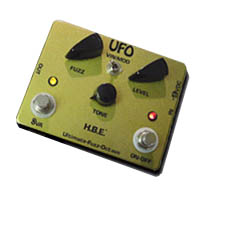
HomeBrew Electronics hand-wires each of their pedals and this one was no different, and was constructed on a perf-board that no doubt took some time to do. The controls on the U.F.O. include Fuzz, Tone, and Volume – certainly easy enough to figure out. A separate footswitch enables you to turn the Octave-up effect on or off. A separate footswitch (true bypass as well) allows you to turn the unit itself on or off.
The U.F.O. utilizes a germanium transistor in its circuit and has a charactertistically “lo-fi” type fuzz effect that fans of those tones will find pleasing. The Octave-up or “Octavia” type feature is very interesting. One has to note that the Octave circuit within the U.F.O. is very primitive by today’s standards, but that’s part of where the charm of this effect comes in.
It is not an effect that works in the same manner as either an analog octave pedal or a digital type “Whammy” effect. A very simple filtering system produces the tones and the Octave-up is also very responsive to some notes more than others. When playing on the lower bass strings, there are times when the Octave-up effect is barely audible. However, playing higher notes in the upper register will allow perfect Jimi-style effects. The pickup used (whether neck, middle, or bridge) also impact the Octave-up effect.
Electro-Harmonix Big Muff Pie reissue U.S.A. and Russia, Price $116 and $79, www.ehx.com
 The EH Big Muff’s historical significance was covered in part one of our Fuzz Feast. Since it’s inception in the late ‘60s, the Big Muff has changed a bit in circuit and certainly in cosmetics, but today the U.S. and Russian reissues are said to be virtually identical circuits and now more true to the originals.
The EH Big Muff’s historical significance was covered in part one of our Fuzz Feast. Since it’s inception in the late ‘60s, the Big Muff has changed a bit in circuit and certainly in cosmetics, but today the U.S. and Russian reissues are said to be virtually identical circuits and now more true to the originals.
It is interesting that with that said, both of these reissue Big Muff’s do sound a little bit different from each other. Admittedly the U.S. reissue is the closest in tone to the vintage Big Muff we sampled in part 1. The tone between them are similar overall, with the original simply having more of a relaxed feel with its sustain, while the U.S. reissue is a bit more aggressive.
The Russian Big Muff is the closest in size to the original and even has the “triangle-layout” like the original, but in tone has some of the mids dampened compared to either the original or U.S. reissue units. In fact, the Russian Big Muff really felt a bit better suited for metal style playing with its bit of mid-scoop to its tone.
Both units are a comparable bargain compared to the original aluminum Muff, whose prices have soared as of late (as have many vintage effect pedals for that matter). In addition, having a warranty and true-bypass switching in both the latest Russian and U.S. built Big Muffs certainly can provide a bit of peace of mind.
MJM Electronics Foxey Fuzz $175.00, www.mjmguitarfx.com
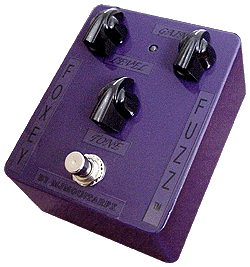 MJM Electronics builds a variety of clone pedals that are widely discussed on various bulletin boards on the Internet. This is in fact where I first discovered the Foxey Fuzz. It was stated to be a clone of the original triangle-knob configuration of Big Muff, but had the advantage of being housed in a smaller enclosure, hand-wired, and with true bypass switching.
MJM Electronics builds a variety of clone pedals that are widely discussed on various bulletin boards on the Internet. This is in fact where I first discovered the Foxey Fuzz. It was stated to be a clone of the original triangle-knob configuration of Big Muff, but had the advantage of being housed in a smaller enclosure, hand-wired, and with true bypass switching.
However, I should say that MJM themselves do not market the Foxey Fuzz as being an identical EH Muff clone – at least not on their site and that is a good thing as the Foxey Fuzz definitely does not sound identical to the original EH triangle-knob Big Muff anyhow. Depending on your interests in tone, this could be a good thing.
What the Foxey Fuzz does sound like however, is a very aggressive silicon transistor Fuzz that is very close in tone to the U.S. reissue Big Muff, but has even more volume boost on tap. It doesn’t take much movement of the volume control to get a loud signal – that was one of the first things I heard and noticed when playing with the Foxey Fuzz.
The tone control is voiced well just as the Big Muffs are and can really help tune in a warm tone to match the adjustments of an amplifier, or it can be dialed in for extreme treble-fuzz type effects more akin to psychedelic ‘60s style tunes.
The Foxey Fuzz is well built and sturdy as many boutique hand-built pedals are these days. The Foxey makes a good substitute for a Big Muff especially if real estate on a pedal board is limited.
Keeley Electronics Fuzz Head, Price $199, www.robertkeeley.com
The first of two hybrid-circuits we’ve looked at, the Keeley Fuzz Head incorporates both fuzz and overdrive within its circuitry to create what Keeley Electronic’s President Robert Keeley describes on his site as the ultimate lead boost. It should be noted that the Keeley Fuzz Head circuit is also unique, not a clone or replication of another design.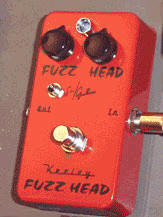
Housed in a small aluminum enclosure, controls on the Fuzz Head are simply Fuzz (Fuzz/overdrive) and Head (Volume), in addition to a switch labeled Si/Ge that switches between Silicon and Germanium transistors in the circuit. The Fuzz Head is also wired by hand and includes a true-bypass switch.
The tone of the circuit is voiced and built by Robert Keeley and his staff, but the Fuzz Head also includes additional caps for those interested in tweaking their Fuzz Heads for more bass, etc. The caps are installed via sockets located by removing the back cover of the Fuzz Head. A battery is supplied and a 9v DC connector is also provided.
The Fuzz Head’s tone is emphasized in the mid and top end of the sound spectrum as to be expected for a lead-boost type of device. True to form, the Fuzz Head definitely has some of the characteristic fuzz tone edge to its tone, but predominantly gives the feel and overtones of a very uniquely-voiced overdrive with light-to-medium gain available on tap. An internal trimmer pot enables you to increase the range of fuzz/overdrive effect as well for even more gain if desired. Per Keeley’s description, the Fuzz Head is designed to provide a balanced fuzz effect, rather than being one that is overly bassy in tone as can be the case with some Fuzz Face type units.
The Si/Ge switch is subtle, but switches between a bit of a smoother type tone, to one that maintains a bit more “grit” or edge to the signal. The Keeley Fuzz Head ultimately may be best suited for those users who already enjoy their guitar and amp’s tone, but simply want some interesting and very unique color and sustain to throw into the mix when going for leads.
Jacques Mercer Box II, Price $175, www.jacquesstompboxes.com
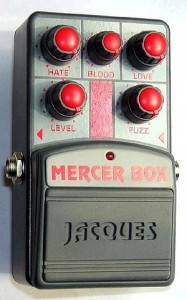 Jacques Mercer Box II is the second of our hybrid effects that we’ve examined, combining both fuzz and overdrive circuits. It is also housed in a very compact enclosure and features a range of 5 controls, with initially-confusing labels such as “Love”, “Blood” “Hate”, etc. Easy battery access without tools and a 9v DC jack round out the Mercer Box II’s feature set.
Jacques Mercer Box II is the second of our hybrid effects that we’ve examined, combining both fuzz and overdrive circuits. It is also housed in a very compact enclosure and features a range of 5 controls, with initially-confusing labels such as “Love”, “Blood” “Hate”, etc. Easy battery access without tools and a 9v DC jack round out the Mercer Box II’s feature set.
The Mercer Box circuit incorporates a germanium transistor as well as more contemporary IC’s to get its range of sounds. The Mercer Box is also unique in this Fuzz Feast as it’s the only pedal featured that can blend the signals of a fuzz and overdrive but also be set to run these types of tones independently as well.
While initially I was a bit confused with the range of controls and in determining how everything is supposed to blend together, the included quick guide helps new users like myself. Within a few moments, I was on my way to getting quite an interesting palette of tones from the Mercer Box.
The user can blend both drive controls (Love and Fuzz) together to go from extreme metal distortion effects, to backing off on the overdrive (Love) and keeping the fuzz going for more vintage-style effects. The e.q. controls (Hate for bass, Blood for highs) are quite active and provide a large range that can be dialed in from the Mercer as well. Hate in particular provides a tremendous amount of low-end thump if it is desired.
For those players looking for a general-purpose all-around box that covers the gamut from vintage fuzz and overdrive, to hard rock and metal tones, the Mercer Box may be the ideal unit to check out. Without a doubt, the Mercer Box II is the most tonally diverse of all the pedals featured in this roundup.
Retroman Lola, Price $175 www.retroman-music.com
Perhaps right after the original Fuzz Face itself, no other fuzz has been as coveted as the Sola-Colorsound ToneBender series. Colorsound also produced many of the Vox Tone Benders as well as the Marshall SupaFuzz of the late ‘60s.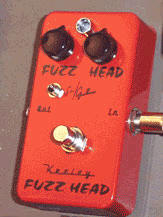
Among the most famous of the Colorsound line was the Tone Bender Professional, MK II, introduced in 1965. Plain and simply, consider this circuit a Fuzz Face with added gain and drive, courtesy of an extra germanium transistor added (three used in total).
The ToneBender MkII was employed by a number of famous players including Jeff Beck (then of the YardBirds), as well as Jimmy Page who used the MkII on the first few Zeppelin albums. As can be imagined, the originals are costly just as the Fuzz Faces are.
With that Retroman has introduced his Lola, a design based on the Colorsound Tone Bender MkII with a few updated, additional features.
The first area to note is its small size. Original Colorsound pedals are similar in size to a typical wah pedal and do take up quite a bit of pedal board real estate. Second is the addition of a bias control on the side of the unit. The bias control adjusts the level of voltage going to the transistor and can shape the sound quite dramatically. Third, there is an internal trimmer pot for adjustment of the signal sent in at input, to vary the fuzz possibilities further between single-coil and humbucking pickups. Finally, is the addition of an on/off switch implemented within the volume control itself. This is useful if you are running the pedal on a board with a battery rather than an external power supply and don’t want to have to unplug the input jack to turn the unit off after each use. On that note, a DC power jack is also included, but most germanium fuzz purists like to use batteries and insist that they (carbon ones in particular) offer a more pleasant tone.
The Retroman Lola incorporates N.O.S. Mullard germanium transistors and is also built with the care and excellence as one would expect from today’s boutique builders.
The tone of the Lola is very full in terms of both distortion gain and tonal range from lows, mids, and highs though it has a crunch mid-emphasis in a somewhat Marshall-like range. It’s easy to emulate and imagine playing those early Zep riffs through the Lola as even with a low-output equipped guitar such as my Stratocaster, there’s plenty of distortion fuzz on tap. With a Humbucking-equipped guitar such as my Les Paul, the Lola has the ability to sustain for quite a bit.
The side-mounted pot controlling bias was especially useful and is quite dramatic in terms of overall tonal shaping that it can offer. Used against a Vox AC-30, the bias control was well set in the middle position, whereas against a Fender Tremolux, it helped to bump up the bias a bit as far as my own personal preferences went.
Because it is a germanium effect, the Lola retains certain characteristics inherent within germanium designs, most notably the ability to really “clean up” the fuzz signal when rolling back the guitar’s volume control. Also, whereas silicon designs such as the later Fuzz Faces as well as the Big Muff for example have a tone that is smoother and more rolled off, the Lola retains much of the crunchier tones. When running at higher gained settings, the Lola smooths out a bit more in exchange for the raspier sonic texturing as one would normally expect. It’s actually sonically an interesting balance between what you’d hear in terms of rasp levels between a germanium fuzz face and the softer overtones of a silicon fuzz (all relatively speaking compared to the early ones of course).
When using less fuzz (labeled Attack), the Lola does get into Fuzz Face-like territory, but still has its own unique sound, tone and feel. Those who are interested in exploring different fuzz tones may be interested in obtaining a Lola as well as a suitable Fuzz Face or clone of one’s preference. There’s definitely a lot of sound to explore from the Lola.
Love my Russian green bubble-font Big Muff. They always claim the big muff isn’t a fuzz (at least on the Kit Rae and Gilmourish sites)- but I remember in grade 8, ca. 1969 or so my buddy had a Guild Foxey Lady fuzz pedal-which was a Big Muff in a shiny chrome box made for Guild by E/H. About ten years ago I picked up one of the Dunlop Fuzz Face reissues from a surplus store (I can’t remember now if it was the blue or the red one, but I seem to recall it was the Hendrix version). Anyway, I didn’t like it at all-way to splatty and harsh. I traded it on something else. I’d like to get a really good Germanium booteeky fuzz though, when I get a few extra bucks.